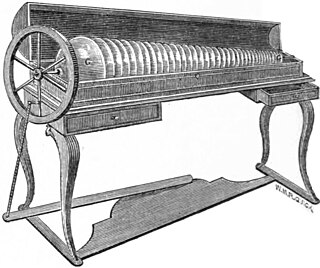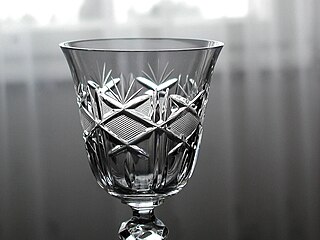
Art glass is a subset of glass art, this latter covering the whole range of art made from glass. Art glass normally refers only to pieces made since the mid-19th century, and typically to those purely made as sculpture or decorative art, with no main utilitarian function, such as serving as a drinking vessel, though of course stained glass keeps the weather out, and bowls may still be useful.

Steuben Glass is an American art glass manufacturer, founded in the summer of 1903 by Frederick Carder and Thomas G. Hawkes in Corning, New York, which is in Steuben County, from which the company name was derived. Hawkes was the owner of the largest cut glass firm then operating in Corning. Carder was an Englishman who had many years' experience designing glass for Stevens & Williams in England. Hawkes purchased the glass blanks for his cutting shop from many sources and eventually wanted to start a factory to make the blanks himself. Hawkes convinced Carder to come to Corning and manage such a factory. Carder, who had been passed over for promotion at Stevens and Williams, consented to do so.

The glass harmonica, also known as the glass armonica, glass harmonium, bowl organ, hydrocrystalophone, or simply the armonica or harmonica, is a type of musical instrument that uses a series of glass bowls or goblets graduated in size to produce musical tones by means of friction. It was invented in 1761 by Benjamin Franklin.

Fire-King is an Anchor Hocking brand of glassware similar to Pyrex. It was formerly made of low expansion borosilicate glass and ideal for oven use. Currently it is made of tempered soda-lime-silicate glass in the US and borosilicate in Japan

Depression glass is glassware made in the period 1929–1939, often clear or colored translucent machine-made glassware that was distributed free, or at low cost, in the United States and Canada around the time of the Great Depression. Depression glass is so called because collectors generally associate mass-produced glassware in pink, yellow, crystal, green, and blue with the Great Depression in America.

A wine glass is a type of glass that is used for drinking or tasting wine. Most wine glasses are stemware (goblets), i.e., they are composed of three parts: the bowl, stem, and foot.
Bakewell Glass is nineteenth-century glassware from Pittsburgh, Pennsylvania, produced by a company founded by Benjamin Bakewell. Bakewell's company can be found under the names ThePittsburgh Glass Manufactory, Bakewell & Page and, Bakewell, Pears & Co. Bakewell glass built a reputation of being both luxurious and utilitarian during the 80 years it was in business.

Edinburgh Crystal was a cut glass manufactured in Scotland from c. 1820s to 2006, and was also the name of the manufacturing company. In addition to drinking glasses, Edinburgh Crystal made decanters, bowls, baskets, and bells, in several ranges.
Cambridge Glass was a manufacturer of glassware formed in 1873 in Cambridge, Ohio. The company produced a range of coloured glassware in the 1920s, initially with opaque shades, but moving on to transparent shades by the end of the decade. Unable to compete with mass-produced glassware, the company closed briefly in 1954, but was reopened in 1955. However, financial difficulties persisted, and, after several ownership changes, the factory closed for good in 1958. Imperial Glass Company purchased the Cambridge Glass molds two years later, and would use them for another three decades until that company went bankrupt in 1984.

A glass harp is a musical instrument made of upright wine glasses.

The A.H. Heisey Company was formed in Newark, Ohio, in 1895 by A.H. Heisey. The factory provided fine quality glass tableware and decorative glass figurines. Both pressed and blown glassware were made in a wide variety of patterns and colors. The company also made glass automobile headlights and Holophane Glassware lighting fixtures. The company was operated by Heisey and his sons until 1957, when the factory closed.
Ravenhead Glass was a glassworks near Ravenhead Colliery, Lancashire, North West England. It was founded in 1850 by Frances Dixon and John Merson after a move from their earlier (1842) factory at Thatto Heath near St Helens. In 1852, this factory was sold to the Pilkington Brothers and Frances Dixon then acquired a 13-acre (53,000 m2) site at Ravenhead, building a new gas-powered glassworks.

Elegant glass is high quality glassware created in the United States during the Depression Era. It was sold for high prices in department stores and given as wedding gifts. Although part of the Depression Era, it is considered by most to be a separate category or sub category of Depression glass. When new, Elegant glass would cost more than standard Depression glass, because it was at least partially handmade, had a cleaner finish, and more vibrant colors. From the 1920s through the 1950s, Elegant glass was an alternative to fine china. Most of the Elegant glassware manufacturers closed by the end of the 1950s, and cheap glassware and imported china took its place.

Hedwig glasses or Hedwig beakers are a type of glass beaker originating in the Middle East or Norman Sicily and dating from the 10th-12th centuries AD. They are named after the Silesian princess Saint Hedwig (1174–1245), to whom three of them are traditionally said to have belonged. So far, a total of 14 complete glasses are known. The exact origin of the glasses is disputed, with Egypt, Iran and Syria all suggested as possible sources; if they are not of Islamic manufacture they are certainly influenced by Islamic glass. Probably made by Muslim craftsmen, some of the iconography is Christian, suggesting they may have been made for export or for Christian clients. The theory that they instead originate from Norman Sicily in the 11th century was first fully set out in a book in 2005 by Rosemarie Lierke, and has attracted some support from specialists.
Early American molded glass refers to glass functional and decorative objects, such as bottles and dishware, that were manufactured in the United States in the 19th century. The objects were produced by blowing molten glass into a mold, thereby causing the glass to assume the shape and pattern design of the mold. When a plunger rather than blowing is used, as became usual later, the glass is technically called pressed glass. Common blown molded tableware items bearing designs include salt dishes, sugar bowls, creamers, celery stands, decanters, and drinking glasses.

Orrefors Glassworks is a glassworks in the Swedish village Orrefors in Småland. Orrefors manufactured crystal glassware and art glass. The range consisted of crystal stemware, barware, vases, and sculptures and lighting products in crystal. The glassworks in Orrefors closed in 2012.
CrowdOptic, Inc. is a privately held San Francisco-based medical technology company founded in 2011. CrowdOptic, led by CEO Jon Fisher, developed augmented reality technology and triangulation algorithms used in medicine, sports, and government that gathers and analyzes data from smart devices based on where they are pointed to identify areas of interest. As of 2016, CrowdOptic remains the only patented solution for wearables like Google Glass and Sony SmartEyeGlass.
J. H. Hobbs, Brockunier and Company was one of the largest and best-known manufacturers of glass in the United States during the 19th century. Its products were distributed worldwide. The company is responsible for one of the greatest innovations in American glassmaking—an improved formula for lime glass that enabled American glass manufacturers to produce high-quality glass at a lower cost. The firm also developed talented glassmakers that started glass factories in Ohio and Indiana.

Cut glass or cut-glass is a technique and a style of decorating glass. For some time the style has often been produced by other techniques such as the use of moulding, but the original technique of cutting glass on an abrasive wheel is still used in luxury products. On glassware vessels, the style typically consists of furrowed faces at angles to each other in complicated patterns, while for lighting fixtures, the style consists of flat or curved facets on small hanging pieces, often all over. Historically, cut glass was shaped using "coldwork" techniques of grinding or drilling, applied as a secondary stage to a piece of glass made by conventional processes such as glassblowing.
Bakewell, Pears and Company was Pittsburgh's best known glass manufacturer. The company was most famous for its lead crystal glass, which was often decorated by cutting or engraving. It also made window glass, bottles, and lamps. The company was one of the first American glass manufacturers to produce glass using mechanical pressing. In the 1820s and 1830s, Bakewell glassware was purchased for the White House by presidents James Monroe and Andrew Jackson. Founder Benjamin Bakewell is considered by some to be father of the crystal glassware business in the United States.














